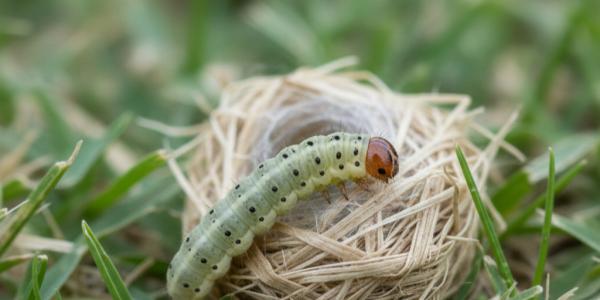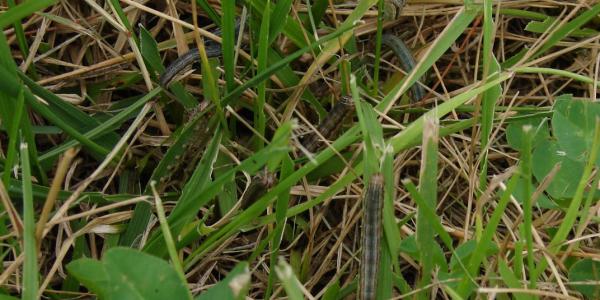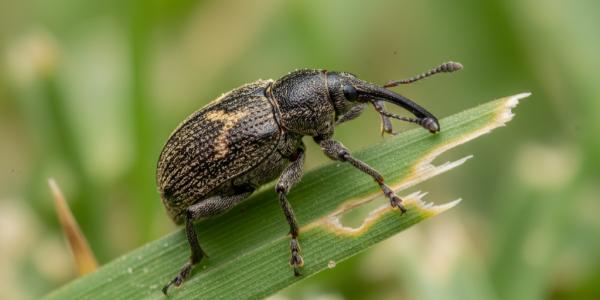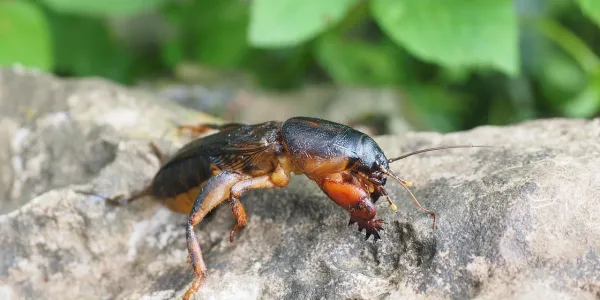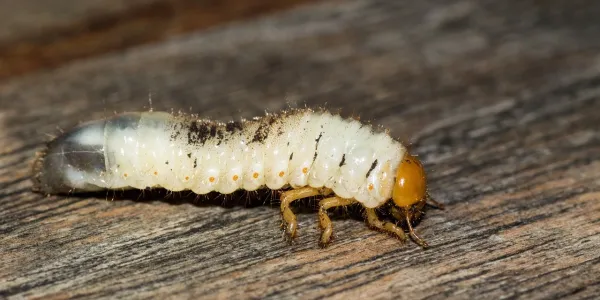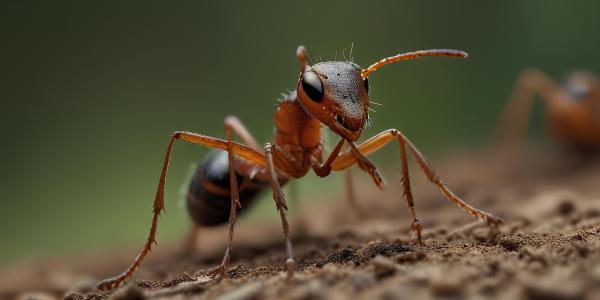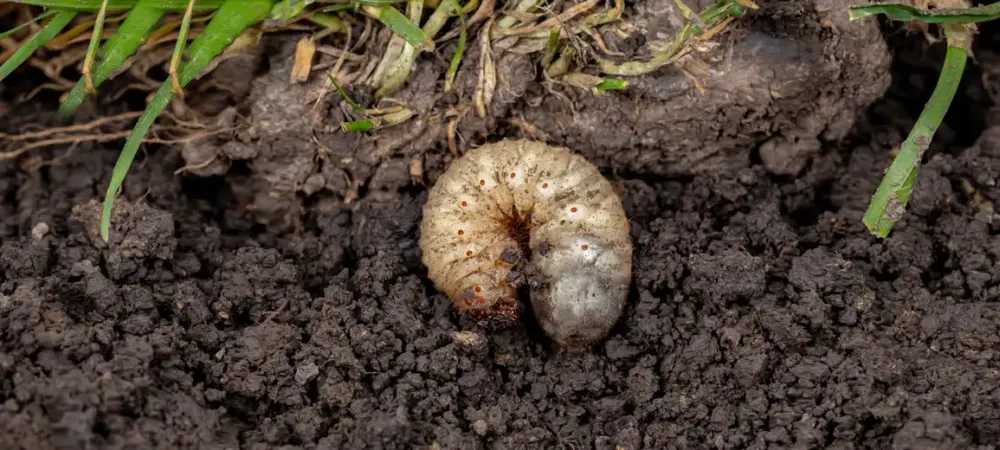
Common Lawn Pests in SC
Healthy lawns still attract insects. The key is knowing what’s normal, what’s not, and when simple checks can save your turf from bigger issues. Below are the pests South Carolina homeowners run into most often, with plain-English tips on how to recognize their activity, what their damage usually looks like, and quick ways to confirm what’s going on before you treat.
Chinch Bugs
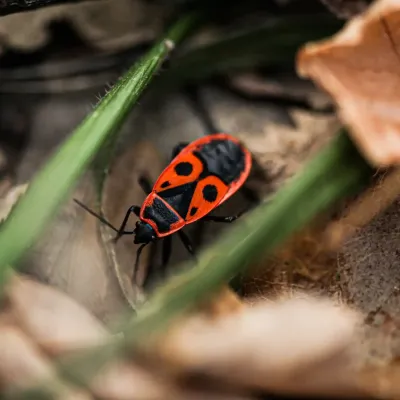
Small insects that suck juices from grass near sunny, dry edges.
- What they look like: Adults look black with white markings; young ones are tiny and reddish with a pale band. You’ll most often see them at the border of sidewalks, driveways, or sunny lawn edges.
- When problems show up: Hot, dry stretches from late spring through early fall.
- Typical damage: Yellowing that looks like drought, beginning in patches that spread even if you water.
- Quick check: Part the grass at the edge of a yellow patch and watch for fast-moving bugs. A “coffee-can test” (open-ended can pressed into the soil and filled with water) will push them to the surface.
Sod Webworms
Caterpillars of small tan moths that chew grass blades at night.
- What they look like: Caterpillars are green to brown and about an inch long. Moths flutter up from the lawn at dusk when you walk through it.
- When problems show up: Late spring through fall, often in waves.
- Typical damage: Ragged, chewed leaf tips and thinning areas that start small and widen.
- Quick check: Look for tiny green pellets (frass) in the thatch and fine silk tunnels near the soil line.
Fall Armyworms
Fast feeders that can thin a yard in days.
- What they look like: Striped caterpillars with a pale “Y” shape on the head.
- When problems show up: Late summer into early fall, especially after warm, rainy periods.
- Typical damage: Sudden off-color patches that turn brown quickly if not treated.
- Quick check: In the morning, mix a gallon of water with a tablespoon of dish soap and pour over a square yard. Larvae will surface within minutes.
Billbugs
Weevils whose larvae feed inside stems and crowns.
- What they look like: Adults are small, grayish weevils with a curved snout. Larvae are cream-colored, legless grubs that stay inside the plant.
- When problems show up: Late spring through summer.
- Typical damage: Grass that breaks off at the crown and looks “hollowed out,” leaving scattered straw-colored spots.
- Quick check: Tug at affected blades near the soil; if they pull free easily and the stems look sawdusty inside, billbugs are likely.
Mole Crickets
Underground tunnelers that sever roots and loosen the soil.
- What they look like: Brown, cricket-like insects with spade-shaped front legs for digging.
- When problems show up: Spring and fall are common complaint periods.
- Typical damage: Spongy or lumpy turf, thinning over tunnels, and increased bird activity as they hunt.
- Quick check: At dusk, soak a 2’×2’ area with soapy water; mole crickets often rise to the surface within a few minutes.
White Grubs (beetle larvae)
Root feeders that cause wide, wilted areas despite regular watering.
- What they look like: C-shaped, off-white larvae with brown heads found 1–3 inches below the surface.
- When problems show up: Late summer through early fall.
- Typical damage: Turf wilts and feels loose underfoot; sections can peel up like a carpet.
- Quick check: Cut three sides of a 1-square-foot flap and peel it back. Finding more than 6–8 grubs in that area usually warrants treatment.
Fire Ants
They don’t eat grass, but they do build mounds and sting.
- What they look like: Soft, crumbly mounds that appear quickly after rain; ants are aggressive when disturbed.
- When problems show up: Warm months with spikes after rainfall.
- Typical impact: Mounds disrupt mowing and outdoor use and can injure pets or people.
- Quick check: Watch for fresh soil mounds without a central hole; activity increases in the morning and late afternoon.
Signs Your Lawn May Have a Pest Problem
- Patches that yellow or brown even with consistent watering.
- Grass that pulls up easily, or turf that feels spongy or “hollow.”
- Ragged or chewed leaf tips rather than a clean mower cut.
- Increased bird, wasp, or raccoon activity pecking or digging at the lawn.
- Nighttime moths flying up from the grass or insects visible when you part the blades.
- Fresh soil mounds or tunneling patterns at the surface.
Smart Next Steps Before You Treat
- Confirm the culprit. A quick soap-water flush or small turf inspection can distinguish caterpillars from grubs or billbugs.
- Target the timing. Many products work best on younger stages; catching issues early improves results.
- Protect beneficial insects. Spot-treat where possible and follow label directions to avoid unnecessary applications.
- Support recovery. Water deeply but not constantly, mow at the right height, and reduce thatch to discourage future infestations.
Professional Lawn Pest Services in South Carolina
Prefer to avoid guesswork? Our lawn care program integrates pest control into a complete turf plan—starting with inspection and diagnosis, followed by targeted treatments, seasonal prevention, and ongoing monitoring. A licensed technician identifies the source of damage, applies the right product at the right time, and guides recovery so your grass thickens, fills in, and stays protected all season. Contact us today to learn more!
